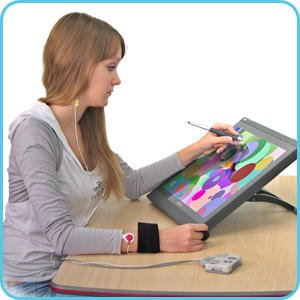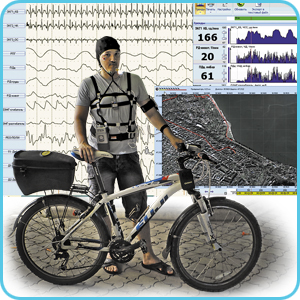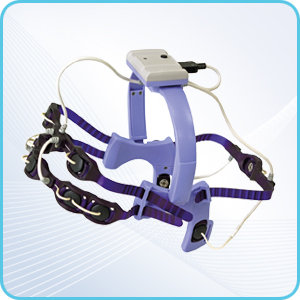Cerebral function monitor "Encephalan-CFM"
CFM / aEEG
Medicom MTD. Medical equipment for electrodiagnosis, rehabilitation and research
Phones: +7 (8634) 62-62-42, 62-62-43, 62-62-44, 62-62-45.
www.medicom-mtd.com
Short products catalog
Cerebral function monitor "EncephalanвАУCFM" is an essential tool for continuous dynamic analysis of electrical brain activity, which effectively complements the monitoring of vital parameters
Dynamics of changes in brain activity, which cannot be traced during short-term EEG study, is clearly represented during continuous EEG monitoring in the form of amplitude-integrated EEG trends (aEEG), compressed spectrum and other CNS quantitative parameters, calculated by the signals received via few (1 to 5) EEG derivations.
Cerebral function monitor "Encephalan-CFM" is designed to solve the problem of risk assessment of brain damage associated with a lack of oxygen (asphyxia), low cerebral perfusion, and with paroxysmal brain activity, which cause sensory, motor and cognitive dysfunctions of different severity particularly in newborns in intensive care units and is widely used in developed countries.
Cerebral function monitor provides continuous dynamic analysis of amplitude-integrated EEG (aEEG) for detection of perinatal asphyxia and epileptiform activity in neonatology, and for neurophysiological control in ischemic strokes and unconscious post-comatose states.
Monitor "Encephalan-CFM" can be delivered in mobile and portable variants.
Option of simultaneous data monitoring of up to 4 patients with representation of results at a doctor's workplace.
view details >>Electroneuromyograph with option of brain evoked potentials study provides quality record of myographic signals and evoked potentials.
Meant for use in neurological and neurophysiological departments, sport medicine and scientific research.
2, 4 or 5-channel modifications or different software versions provide both inexpensive and elite expert class devices.
Wireless connection of patient transceiver-recorder with remote control and footswitch decreases the number of wire connections and increases comfort for patients and doctors during study carrying out.
The original remote control (RC) is an equivalent of a functional keyboard вАУ it simplifies the carrying out of multiple standard tests without the use of a computer keyboard and a mouse. Managing a neuromyograph with a remote control is as easy as managing a TV-set remote control.
view details >>High technical performance and a unique option to change the configuration of portable electroencephalograph-recorder" Encephalan-EEGR-19/26" ensure its effective application in various fields of neurophysiology.
EEG-20 or EEG-32 connectors on a special stand allow quickly transforming a portable encephalograph into a stationary electroencephalograph (with 20 or 32-channels) for classical applications in the room of neurophysiology and functional diagnostics.
Connectors make it easy to connect/disconnect autonomous patient transceiver-recorder ABP-26 and use EEG electrodes with touchproof connectors (cup or bridge) or electrode caps from the set of EEG electrodes "Encephalan-ES".
Electroencephalographs floor stand is equipped with phono-photostimulators for EEG functional tests and EP study.
EEG-recorder is used for short-term and continuous EEG studies вАУ in a hospital room or at patient's home, including EEG-video monitoring for the differential diagnosis of epilepsy.
Sales package of electroencephalograph-recorder "EncephalanвАУEEGRвАУ19/26", including patient transceiver-recorder, portable computer, electrodes, sensors and accessories easily fits into a small bag.
The best tool for continuous multichannel monitoring of electrical brain activity (EEG) in the emergency room and intensive care units with the help of software for neuromonitoring "Encephalan-NM" and software for cerebral functions monitoring "Encephalan-CFM". Provides comfortable visualization of various neurophysiological data and effectively complements the monitoring systems of vital parameters.
Electroencephalograph-recorder provides high noise immunity from the effects of different equipment in ER and ICU.
Convenience of the required CPR and patient care is ensured by wireless data transmission to a monitor located at a distance of 6 meters.
Continuous record of electroencephalogram onto the memory card integrated into the patient transceiver-recorder ABP-26, and a special set of electrodes "Encephalan-ES" provide comfortable carrying out of autonomous EEG studies (Holter EEG) in natural patient environment, both in a hospital ward or at home, during active wakefulness and sleep.
Multiparameter record, analysis over 50 signals and parameters, and also additional software provide use of electroencephalograph as a multifunctional neuromodular diagnostic system.
Continuous autonomic EEG-study is recommended for:
ElectroencephalographsвАУrecorders "EncephalanвАУEEGRвАУ19/26". Modification "Mini"
EEG / Holter EEG
Four options for using the basic device вАУ autonomous patient transceiver-recorder ABP-10 вАУ with a large number of various wireless modules and sensors expand the field of application:
Records EEG by 9 derivations in telemetric or autonomous (EEG-Holter) mode and is applied for:
10 polygraphic channels in a patient transceiver-recorder and a large set of sensors allow creating a variety of options for multiparameter record for biofeedback training.
EEG record by 9 derivations provides an optimal amount of data for neurofeedback procedures.
Effectively used in occupational medicine for rehabilitation, educational technologies, scientific research and for special training.
A unique option of combination of two or three patient transceivers-recorders ABP-10 with additional modules and sensors allows creating multifunctional polygraphic systems with synchronous recording of more than 30 different signals.
Record of physiological parameters in apparently healthy people is applied as a multifunctional monitoring in sports medicine and studies of operator performance.
Portable and autonomous equipment (data transmission via the telemetric channel or recording onto a memory card) allows conducting research under different conditions вАУ from a stationary scientific laboratory to field conditions (for example, training at the main sport ground or in training camps).
view details >>19 or 21-channel (up to 64 digital derivations) electroencephalographs-analyzers EEGA-21/26 "Encephalan-131-03" are an effective and reliable tool for classic electroencephalography at stationary use.
modification 08: 19 EEG channels + 6 REG channels + 1 polygraphic channel (ECG);
modification 10: 21 EEG channels + 6 REG channels + 4 polygraphic channels + 1 additional channel.
modification 11: 21 EEG channels + 4 polygraphic channels +1 additional channel.
A unique option of synchronized EEG and REG study (modifications 08 and 10) provides new diagnostic information about the relationship of brain activity and cerebral blood flow for considering vascular factor in epilepsy, for diagnostics of syncopal states and cerebrovascular disorders at hyperventilation functional tests, and also reduces the total study time.
Phono-, photostimulation and chess pattern stimulation for EP studies during EEG studies. Patient button unit for cognitive EP study (MMN, CNV, P300).
"Optimal", "professional" and "elite" software suits provide a wide range of functionality for EEG analysis for any application. Optional software extends the functionality of electroencephalograph.
view details >>Continuous multichannel synchronous recording of EEG / PSG data and video on the state of the patient is the "gold standard" for the differential diagnosis of epilepsy and sleep disorders:
EEG video monitoring kit and the software "Encephalan-Video" in combination with electroencephalograph-recorder "Encephalan-EEGR-19/26", or electroencephalograph-analyzer "Encephalan-131-03", Cerebral function monitor "Encephalan-CFM" provide a synchronized high-quality record of video data and physiological parameters of the patient.
Continuous simultaneous EEG video monitoring can be carried out in specialized wards of epileptological and neurological departments with a stationary video equipment or in natural environment of the patient (e.g. at home) using portable (mobile) versions of video equipment.
For the first time the company provides an autonomic video equipment kit for synchronized video record (up to 1 frame accuracy) with the EEG data onto the internal video memory card of a recorder, which sets a new level of innovation in autonomous EEG studies.The videorecorder can be used by medical staff or relatives of the patient for video fixation of paroxysmal and other behavioral manifestations during autonomous EEG/PSG studies (Holter EEG).
view details >>Type IV AASM*
for respiratory screening (apnea screening)
Signals and parameters:
Recording modes:
Over 10-hour record of physiological data onto the memory card.
As a result of the study, necessary reports on sleep statistics are generated based on automatically detected events.
Type III AASM*
* AASM вАУ American Academy of Sleep Medicine.
for apnea screening and cardiorespiratory monitoring
Supplemented with wireless module Poly-4
Signals and parameters:
Polysomnography is a "gold standard" of sleep disorders diagnosis.
Type II/I AASM
Models: AT-Somno (Type II),
AT-Somno-Video (Type I)
Provides telemetric and autonomous record of physiological signals (from 13 and more channels in various combinations), including 2, 6 or 8 EEG derivations using autonomous patient transceiver-recorder ABP-10, wireless pulse oximeter module, other modules, electrodes, and sensors.
Provides cardiorespiratory disorders analysis, displaying brain rhythms power indices, EOG and EMG amplitude, parameters of respiration, movements, snoring and ECG in a form of trends for quick search of EEG patterns, identification of sleep stages, as well as for manual and automatic hypnogram building.
Automatic calculation of additional sleep statistical parameters by EEG, such as:
Type II/I AASM
Models: AT-PSG (Type II), AT-PSG-Video (Type I), AT-PSG-Video-Poly (Type I)
Provides telemetric and autonomous record of physiological signals (from 26 and more channels in various combinations), including 6, 11 or 32 EEG derivations using autonomous patient transceiver-recorder ABP-26, wireless pulse oximeter module, other modules, electrodes, and sensors.
Provides cardiorespiratory disorders analysis, displaying brain rhythms power indices, EOG and EMG amplitude, parameters of respiration, movements, snoring and ECG in a form of trends for quick search of EEG patterns, identification of sleep stages, as well as for manual and automatic hypnogram building.
Additionally provides detection of epileptic patterns, classification of spike-waves in relation to sleep structure, as well as various methods of EEG quantitative analysis.
Extended package of reports in accordance with international standards generally accepted in somnology (AASM).
When working with a PC in telemetric mode with the oversight of a sleep technologist, polysomnographs can be supplemented with a kit of video equipment (mobile or stationary) with "Encephalan-Video" software for synchronized night video monitoring.
Provides visual analysis of paroxysmal activity synchronously with EEG for differential diagnosis of epilepsy and detection of symptoms of sleep disorders.
view details >>"Rehacor" Software for Functional Biocontrol with Biofeedback Training uses the "physiological mirror" principle for carrying out biofeedback and neurofeedback procedures and promotes learning skills of psychosomatic regulation for the purpose of rehabilitation and health, as well as improving psychophysiological capabilities.
Biofeedback procedures can be carried out with the use of various equipment manufactured by Medicom MTD Ltd.:
Basic device вАУ 4-channel patient multifunction transceiver "Rehacor"
Stationary variant of patient multifunction transceiver "Rehacor" is used in rehabilitation rooms and health centers,
and ensures the conduct of biofeedback procedures, psychological and psychophysiological testing as well as combination
of above mentioned functional capabilities.
Basic device вАУ 4-channel wireless patient transceiver-recorder ABP-4
Can be used in stationary and portable variants. Allows carrying out biofeedback procedures without restricting patient's activity,
which is particularly effective in sport, occupational medicine and educational technologies.
Additional wireless devices extend the number of channels for up to 8.
Biofeedback training is efficiently used for:
Basic device вАУ is a 10-channel wireless autonomous patient transceiver-recorder ABP-10.
Can be used in stationary and portable variants.
The main features:
Basic wireless device вАУ 26-channel wireless autonomous patient transceiver-recorder ABP-26
Can be used in stationary and portable variants.
The main features:

It uses the original, innovative technology, which includes autodocumentation of a testing process, hand motility analysis of a subject, additional synchronous recording of psychophysiological parameters (pictopolygraphy) and provides a new level of psychological and psychophysiological diagnostics.

There is a unique opportunity of combination of two or three patient units ABP-10 with additional modules and sensors, which allows you to create multifunctional polygraphic systems with synchronous recording of more than 30 different signals.
During polygraphic record of EEG and other parameters all the functionality of the main and optional software is available, which provides a wide range of applications in various fields вАУ sports and occupational medicine, scientific research.
Multiparameter record and control over the ongoing processes contribute to effective application of polygraphic system to functional biocontrol with biofeedback.
Eye-tracker ATV-1 is designed to control visual perception process вАУ to measure gaze with high frequency and accuracy.
Eye-tracker is used in the educational process, scientific research and psychophysiology, and is not a medical device.
Desktop application with individual monitor
Placed on the stand and applied with a big screen.
Option of simultaneous work with several participants in the network mode.
The control of the visual perception process (eye-tracking) is used to evaluate ergonomics of computer interface, the efficiency of advertising and for science research in neuromarketing, neurophychology, cognitive psychology, developmental psychology, sociology, etc.
High-tech electronic optical-mechanical system of eye-tracker allows:
Ultra-small devices uses advance digital technologies for data acquisition and transmission (Bluetooth Low Energy) and expands perspectives for wide applications of distributed network registration of neurophysiologic and psycho physiological information about state of single person or group.

Ultra-small wireless EEG registration modules, EEG-headsets and Bio-wristband are used in the educational process, scientific research and psychophysiology, and are not medical devices.
for registration ofphotoplethysmogram, skin conductivity, electrocardiogram and movement activity
with AgCl electrodes with solid-gel parts
with Ag/AgCl electrodes for contact gel (24 EEG channels)
|
Phones: |
Frunze str., 68, Taganrog, |
| © 1997-2024 Medicom MTD Ltd All rights reserved | |
